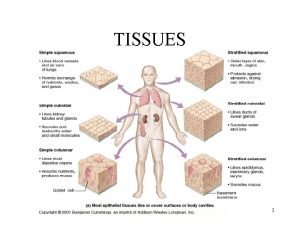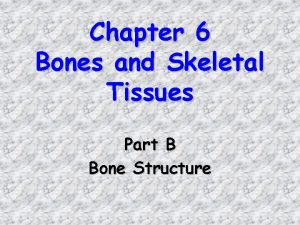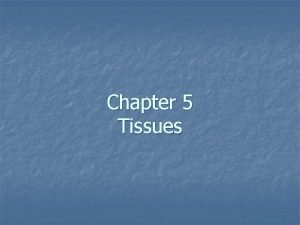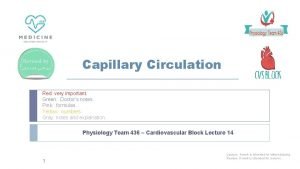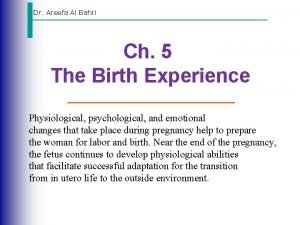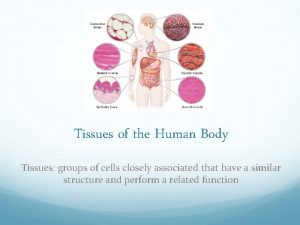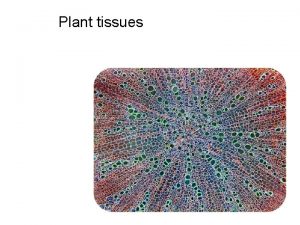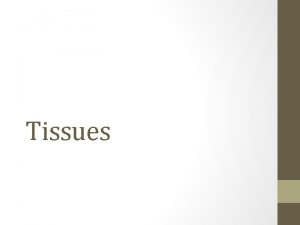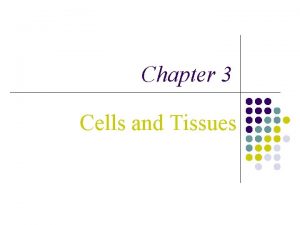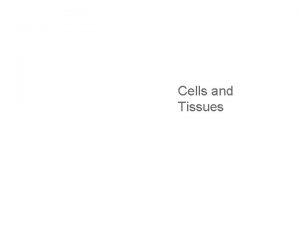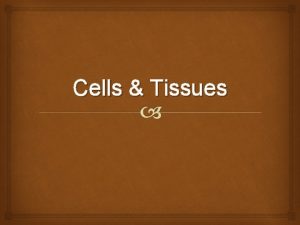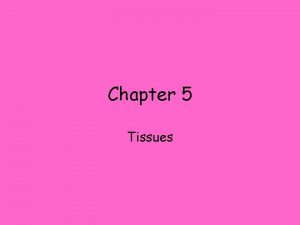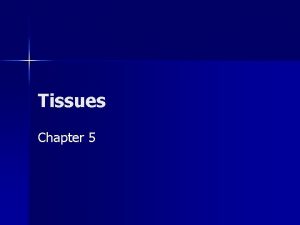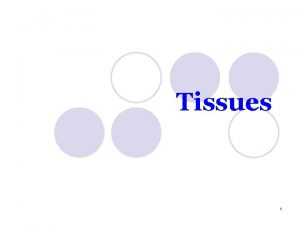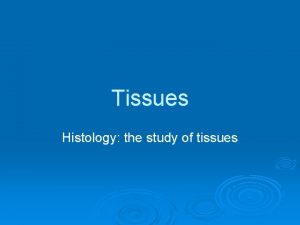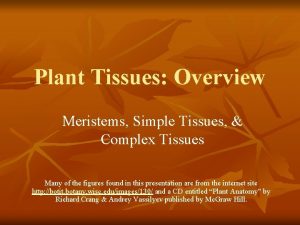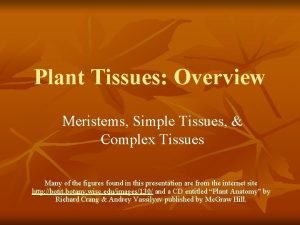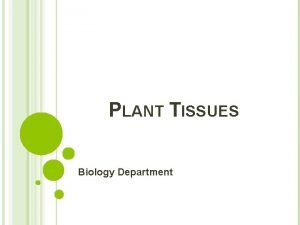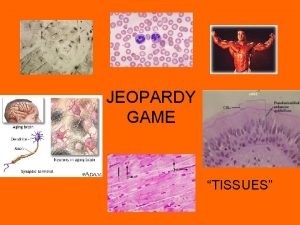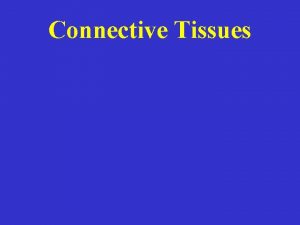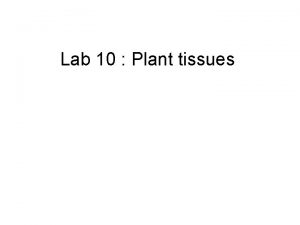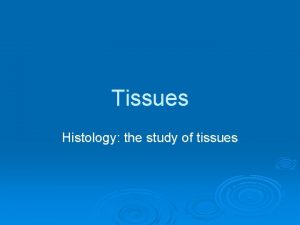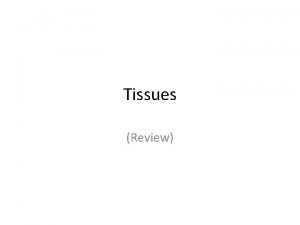CHAPTER 3 CELLS AND TISSUES Cells And Tissues



































- Slides: 35

CHAPTER 3 – CELLS AND TISSUES Cells And Tissues Objectives: 1. Demonstrate an Understanding of the basic organization of the cell 2. Categorize the relationship of the cell and its functions to the more complex levels of organization within the body 3. know the four major categories of tissues and their location, structure, and function

CELL THEORY Cell Theory: 1. The cell is the unit of structure of all living things 2. The cell is the unit of function of all living things 3. All cells come from preexisting cells


Anatomy of a Generalized Cell Remember -- all cell types are not exactly like each other, they often have some basic parts and functions that are common to all cells. There are three main regions to a cell • nucleus • cytoplasm • plasma membrane

Resources for the cell: for your review: Cellsalive. com http: //cellsalive. com/ Biology 4 kids http: //www. biology 4 kids. com/files/cell_main. h tml Animal Cell Structure : http: //micro. magnet. fsu. edu/cells/animalcell. ht ml

In this section we will discuss some of the types of cells built for specific functions: Cells that connect body parts Fibroblast- this type of cell secretes cable-like fibers. It has plenty of rough ER and large Golgi Apparatus. These structures are necessary to secrete the proteins that are the building blocks of the cable-like fiber structures Cells that cover and line body organs Epithelial cells - shaped much like the honeycomb of a beehive. This allows the cells to be stacked into sheets. It has abundant intermediate filaments that resist being torn when they are rubbed or pulled

Cells that move organs and body parts Muscle cells ( skeletal and smooth) - these are elongated cells with numerous contractile filaments. These filaments are able to contract to move bones or change the size of internal organs Cell that store nutrients Fat cells- these contain a large lipid droplet in their cytoplasm. This results in their large sperical shape. Cells that fight disease Macrophages- This type of cell extends large psuedopods to crawl through tissue to reach sites of infection. The lysosomes within the cell digest the microorganisms that it engulfs. A

Cells that fight disease Macrophages- This type of cell extends large psuedopods to crawl through tissue to reach sites of infection. The lysosomes within the cell digest the microorganisms that it engulfs. A macrophage is a type of phagocytic cell Cells that gather information and control body functions (Neurons- Nerve cells)- This type of cell is equipped with long processes for the reception of messages. The cell can then transmit these messages to other structures found in the body. The processes are covered wit an extensive plasma membrane swim.

Cells of reproduction Oocyte (the egg cell)- This is the largest cell in the human body. It contains many copies of all organelles. These are ready to be distributed to the daughter cells that would result from fertilization. Sperm - This long streamlined cell is built for swimming. It has a long flagellum that enables it to swim

Body Tissues 1. Cells are arranged in tissues that provide specific functions for the body. 2. Cells of different tissues are structured differently, which leads to their differences in function. 3. The tissues of the human body include four major types.

Body Tissues 1. 2. 3. 4. Epithelial Connective Muscle Nervous

No you don’t have to copy – but you need to know examples

Epithelial tissue is widespread throughout the body, it covers organs, and lines body surfaces. Epithelial tissues are anchored to a basement membrane, are made up of tightly packed cells containing very little intercellular material, generally lack blood vessels, and are replaced frequently. They function in protection, secretion, absorption, excretion, and sensory

EPITHELIAL TISSUE - types 1. Simple Squamous Epithelium 2. Simple Columnar Epithelium 3. Pseudostratified Columnar Epithelium 4. Stratified Squamous Epithelium 5. Stratified Cuboidal Epithelium 6. Stratified Columnar Epithelium 7. Transitional Epithelium


CONNECTIVE TISSUES - characteristics A. General Characteristics Connective tissues bind, support, protect, serve as frameworks, fill spaces, store fat, produce blood cells, protect against infection, and repair tissue damage. Unlike epithelial tissues, connective tissues have abundant matrix, or intercellular material, throughout, and have good blood supplies (except cartilage).

CONNECTIVE TISSUES – Cell types B. Major Cell Types The fibroblast is the most common cell type, and is a fixed, star-shaped cell that secretes fibers and is large in size. Wandering macrophages function as scavenger cells and defend against infection. Mast cells are large and are located near blood vessels where they release heparin (anticoagulant) and histamine (promotes inflammation).

Fibroblasts macrophag e Mast Cells

Connective Tissue Fibers 1) Strong collagenous fibers (white fibers), made of the protein collagen, add strength for holding body parts together. 2) Elastic fibers (yellow fibers), fibers made of the protein elastin, are stretchy and add flexibility to certain types of connective tissues. 3) Reticular fibers are thin collagenous fibers that form supportive networks in a variety of tissues.



Loose Connective (areolar) Tissue This type of tissue forms delicate, thin membranes throughout the body that bind body parts together such as skin and underlying organs. The majority of the cells are fibroblasts that are separated by a gel-like ground substance that contains collagenous and elastic fibers.

Adipose Tissue Adipose tissue is loose connective tissue designed to store fat. It is found beneath the skin, around joints, padding the kidneys and other internal organs, and in certain abdominal membranes

Dense Connective Tissue - densely packed collagenous fibers – is very strong but lacks a good blood supply. - found as part of tendons and ligaments. hyaline cartilage, is white with abundant fine collagen fibers, is found at the ends of bones, and supports respiratory passages. Elastic cartilage, with elastic fibers, provides a framework for the external ears and parts of the larynx. Fibrocartilage, with many collagenous fibers, is a tough tissue that provides a shock -absorbing function in intervertebral disks and in the knees and pelvic girdle.


Bone is the most rigid connective tissue, with deposits of mineral salts and collagen within the matrix. Bone internally supports the body, protects, forms muscle attachments and is the site for blood cell formation. Bone cells, called osteocytes, lie within lacunae and are arranged in concentric circles (osteons) around osteonic canals interconnected by canaliculi. Bone has a good blood supply, enabling rapid recovery after an injury.


Blood is composed of cells (red and white) suspended in a liquid matrix called plasma. It functions to transport substances throughout the body.

Muscle Tissues: General Characteristics Muscle cells, or fibers, can contract and consist of three major types. Skeletal (striated) Smooth Cardiac (heart)

Skeletal Muscle Tissue Skeletal muscle is attached to bone and can be controlled by conscious effort (voluntary). The cells (muscle fibers) are long and cylindrical, striated, have many nuclei and contract from nervous impulse.

Smooth Muscle Tissue Smooth muscle tissue lacks striations, is uninucleate, and consists of spindleshaped cells. This involuntary muscle is found in the walls of internal organs, and in the digestive tract, blood vessels, and urinary bladder.

Cardiac Muscle Tissue Cardiac muscle tissue is found only in the heart and consists of branching fibers that are connected to each other with intercalated disks. This involuntary muscle has a single nucleus in each cell but appears striated.


Nervous Tissues: Nervous tissues are found in the brain, spinal cord, and nerves. Neurons, or nerve cells, conduct nervous impulses while helper cells, or neuroglia, insulate, support, and protect the neurons

 Body tissue
Body tissue The 4 tissues
The 4 tissues Body tissues chapter 3 cells and tissues
Body tissues chapter 3 cells and tissues Body tissues chapter 3 cells and tissues
Body tissues chapter 3 cells and tissues Eisonophil
Eisonophil Which part of the cell contains genetic material
Which part of the cell contains genetic material Chapter 3 cells and tissues figure 3-7
Chapter 3 cells and tissues figure 3-7 What is the function of the golgi apparatus
What is the function of the golgi apparatus Tissues are groups of similar cells working together to
Tissues are groups of similar cells working together to Tissues are groups of similar cells working together to
Tissues are groups of similar cells working together to Where are loins on a human
Where are loins on a human Tissues are groups of similar cells working together to:
Tissues are groups of similar cells working together to: Nondisjunction in meiosis
Nondisjunction in meiosis Chapter 6 bones and skeletal tissues
Chapter 6 bones and skeletal tissues Olfactory groove keros classification
Olfactory groove keros classification Chlorocruorin
Chlorocruorin Plant cell animal cell venn diagram
Plant cell animal cell venn diagram Masses of cells form and steal nutrients from healthy cells
Masses of cells form and steal nutrients from healthy cells Chapter 5 tissues
Chapter 5 tissues Tubular lumen
Tubular lumen Thyroid gland
Thyroid gland Somatic vs gamete
Somatic vs gamete Somatic cells vs germ cells
Somatic cells vs germ cells Prokaryotic v eukaryotic
Prokaryotic v eukaryotic Prokaryotic cell
Prokaryotic cell Organelle trail
Organelle trail Pseudostratified vs simple columnar
Pseudostratified vs simple columnar 4 types of eukaryotic cells
4 types of eukaryotic cells Prokaryotic cell wall
Prokaryotic cell wall Cell substance
Cell substance Capilary beds
Capilary beds Brow presentation
Brow presentation Specialised connective tissues
Specialised connective tissues Body tissue
Body tissue Meristematic tissue flow chart
Meristematic tissue flow chart 3 tissues of a plant
3 tissues of a plant









